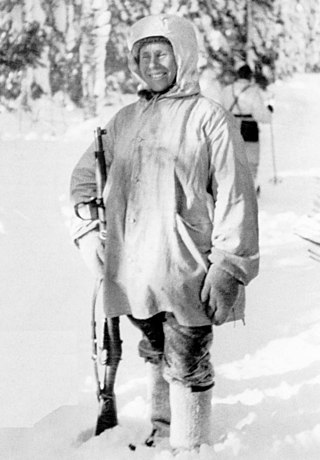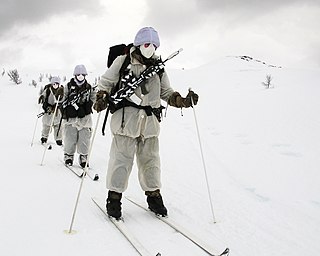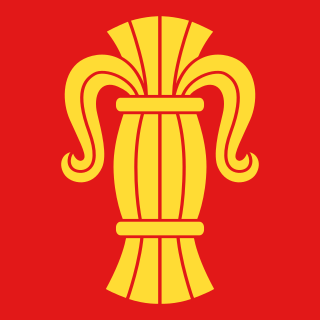The Winter War was the 1939-1940 war between Finland and the Soviet Union.
Winter War may also refer to:
The Cold War was a geopolitical, ideological, and economic struggle after World War II between the United States and the Soviet Union.

Rovaniemi is a city and municipality of Finland. It is the administrative capital and commercial centre of Finland's northernmost province, Lapland, and its southern part Peräpohjola. The city centre is situated about 6 kilometres south of the Arctic Circle and is between the hills of Ounasvaara and Korkalovaara, at the confluence of the river Kemijoki and its tributary, the Ounasjoki. It is the second-largest city of Northern Finland after Oulu, and, together with the capital city Helsinki, it is one of Finland's most significant tourist cities in terms of foreign tourism.
Thunderbird, thunder bird or thunderbirds may refer to:

Norrland is the northernmost, largest and least populated of the three traditional lands of Sweden, consisting of nine provinces. Although Norrland does not serve any administrative purposes, it continues to exist as a historical, cultural, and geographic region; it is often referred to in everyday language, e.g., in weather forecasts. Several related Norrland dialects form a distinct subset of dialects of the Swedish language separate from those to its south.

Lapland is the largest and northernmost region of Finland. The 21 municipalities in the region cooperate in a Regional Council. Lapland borders the region of North Ostrobothnia in the south. It also borders the Gulf of Bothnia, Norrbotten County in Sweden, Troms and Finnmark County in Norway, and Murmansk Oblast and the Republic of Karelia in Russia. Topography varies from vast mires and forests of the South to fells in the North. The Arctic Circle crosses Lapland, so polar phenomena such as the midnight sun and polar night can be viewed in Lapland.

The "Miracle on Ice" was an ice hockey game during the 1980 Winter Olympics in Lake Placid, New York. It was played between the hosting United States and the Soviet Union on February 22, 1980, during the medal round of the men's hockey tournament. Though the Soviet Union was a four-time defending gold medalist and heavily favored, the United States upset them and won 4–3.

Simo Häyhä, often referred to by his nickname, The White Death, was a Finnish military sniper in World War II during the 1939–1940 Winter War against the Soviet Union. He used a Finnish-produced M/28-30 and a Suomi KP/-31 submachine gun. He is believed to have killed over 500 enemy soldiers during the Winter War, the highest number of sniper kills in any major war. Because of this, he is often regarded as the deadliest sniper of all time.
What or WHAT may refer to:

An ushanka, also called an ushanka-hat, is a Russian fur cap with ear-covering flaps that can be tied up to the crown of the cap, or fastened at the chin to protect the ears, jaw, and lower chin from the cold. An alternative is to bend the flaps back and tie them behind the head, which is called "ski-style" — this offers less protection from the elements, but much better visibility, essential for high-speed skiing. The dense fur also offers some protection against blunt impacts to the head. They are also traditionally worn in the Baltic region including Sweden and Finland and the whole eastern European region.

Cold-weather warfare, also known as arctic warfare or winter warfare, encompasses military operations affected by snow, ice, thawing conditions or cold, both on land and at sea. Cold-weather conditions occur year-round at high elevation or at high latitudes, and elsewhere materialise seasonally during the winter period. Mountain warfare often takes place in cold weather or on terrain that is affected by ice and snow, such as the Alps and the Himalayas. Historically, most such operations have been during winter in the Northern Hemisphere. Some have occurred above the Arctic Circle where snow, ice and cold may occur throughout the year. At times, cold or its aftermath—thaw—has been a decisive factor in the failure of a campaign, as with the French invasion of Russia in 1812, the Soviet invasion of Finland in 1939, and the German invasion of the Soviet Union during World War II.
A wolverine is a stocky and muscular carnivorous mammal that resembles a small bear.
Fire and Ice may refer to:
Talvisota may refer to:
Joker(s) or The Joker(s) may refer to:
Ässät or Ässä may refer to:

Vaasa, in the years 1855–1917 as Nikolainkaupunki, is a city on the west coast of Finland. It received its charter in 1606, during the reign of Charles IX of Sweden and is named after the Royal House of Vasa. Vaasa has a population of 67,631, and is the regional capital of Ostrobothnia. Vaasa is also well known as a major university and college city in Finland.
Jari Laukkanen may refer to:
Coldest winter may refer to:
Coldest city may refer to:

Winter of the Dead is a Finnish 2005 short film written and directed by Markus Heiskanen. It tells story about a few survivors in Finland devastated by nuclear winter, where a zombie apocalypse has begun.